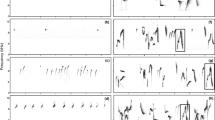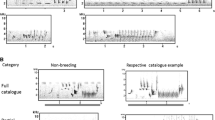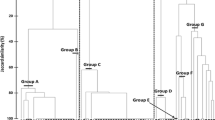Summary
The relationship was studied between song-post distances and the extent of vocal repertoire sharing in 34 territorial nightingales settling in six homogeneously structured habitats. Repertoires were compared on the basis of shared song types and distances were measured between nocturnal song posts of first-order and higher-order neighbours. Our results showed that male nightingales shared fewer song types with very close and more distant neighbours than with neighbours at intermediate distances. This distribution is explained by the interaction betwee repelling and attracting components, which depends on the distance between song posts.
Similar content being viewed by others
References
Baker MC, Mewaldt LR (1978) Song dialects as barriers to dispersal in White-crowned Sparrows (Zonotrichia leucophrys nuttalli). Evolution 32:712–722
Bertram B (1970) The vocal behaviour of the Indian Hill-Mynah (Gracula religiosa). Anim Behav Monogr 3:79–192
Güttinger HR (1977) Variable and constant structures in Green Finch song (Chloris chloris) in different locations. Behaviour 60:304–318
Harris AM, Lemon RE (1972) Songs of Song Sparrows (Melospiza melodia) individual variation and dialects. Can J Zool 50:301–309
Hilprecht A (1965) Nachtigall and Sprosser. Neue Brehm Bücherei, Bd 143, Ziemsen, Wittenberg
Howard RD (1974) The influence of sexual selection and interspecific competition on Mockingbird song (Mimus polyglottos). Evolution 28:428–438
Hultsch H (1980 a) Beziehungen zwischen Struktur, zeitlicher Variabilität und sozialem Einsatz des Gesangs der Nachtigall (Luscinia megarhynchos B.), Dissertation, FB Biologie, FU Berlin (1980)
Hultsch H (1980b) Beschleunigung und Verzögerung von vokalen Antworten auf auditorische Reizmuster bei Nachtigallen (Luscinia megarhynchos B.). Verh Dtsch Zool Ges 1980:343
Jenkins P (1977) Cultural transmission of song patterns and dialect development in a free living bird population. Anim Behav 25:305–399
Kreutzer M (1979) Etude du chant chez le Bruant zizi (Emberiza cirlus), le répertoire, charactéristiques et distribution. Behaviour 71:291–321
Kroodsma DE (1974) Song learning, dialects and dispersal in the Beckwick's Wren. Z Tierpsychol 35:352–380
Marler P, Tamura M (1962) Song “Dialects” in three populations of White-crowned Sparrows. Condor 64:363–399
Nottebohm F (1969) The song of the Chingolo (Zonotrichia capensis) in Argentinia: description and evaluation of a system of dialects. Condor 71:299–315
Nottebohm F (1972) The origins of vocal learning. Am Nat 106:116–140
Schmidt H (1971) Repertoirevergleiche an Amseln (Turdus merula) in einem Freiburger Sidllungsgebiet. M Th Lab Todt, Univ Freiburg
Thielcke G (1969) Geographic variation in bird vocalisations. In: Hinde RA (ed) Bird vocalisations. Cambridge Univ Press, pp 311–339
Thompson WL (1970) Song variation in a population of Indigo Buntings. Auk 87:58–71
Todt D (1971) Äquivalente und konvalente gesangliche Reaktion einer extrem regelmäßig singenden Nachtigall (Luscinia megarhynchos B.). Z Vergl Physiol 71:262–285
Todt D (1981) On functions of vocal matching: Effect of counterreplies on song-post choice and singing. Z Tierpsychol (in press)
Todt D, Hultsch H, Heike D (1979) Conditions affecting song acquisition in Nightingales. Z Tierpsychol 51:23–35
Trainer JM (1980) Comments on the kin association model of bird song dialects. Anim Behav 28:814–870
Treisman M (1978) Bird song, dialects, repertoire size and kin association. Anim Behav 26:814–817
Wolffgramm J (1979) Vergleich der hochvariablen Gesangsvorträge benachbarter Amseln. Verh Dtsch Zool Ges 1979:237
Author information
Authors and Affiliations
Rights and permissions
About this article
Cite this article
Hultsch, H., Todt, D. Repertoire sharing and song-post distance in nightingales (Luscinia megarhynchos B.). Behav Ecol Sociobiol 8, 183–188 (1981). https://doi.org/10.1007/BF00299828
Received:
Accepted:
Issue Date:
DOI: https://doi.org/10.1007/BF00299828




